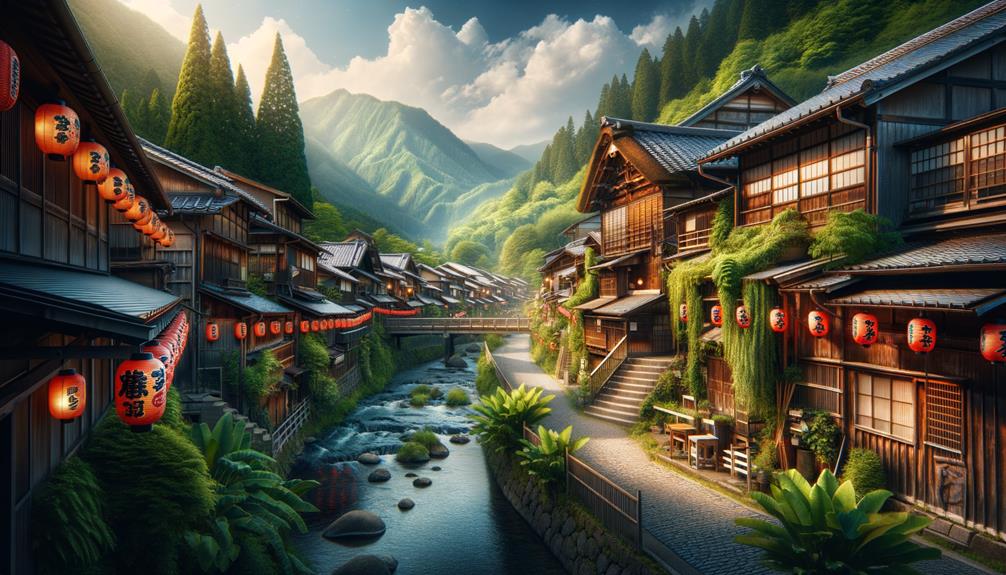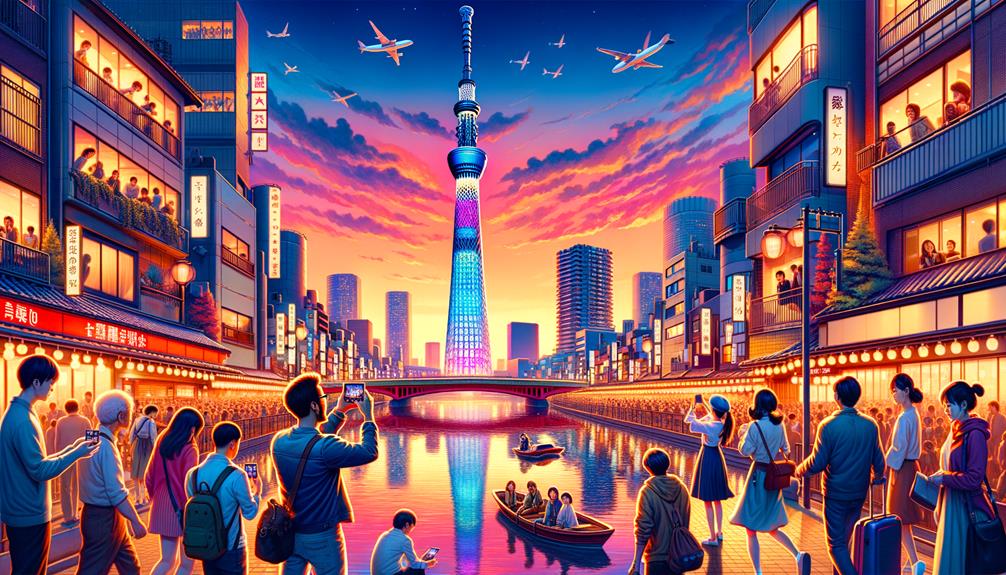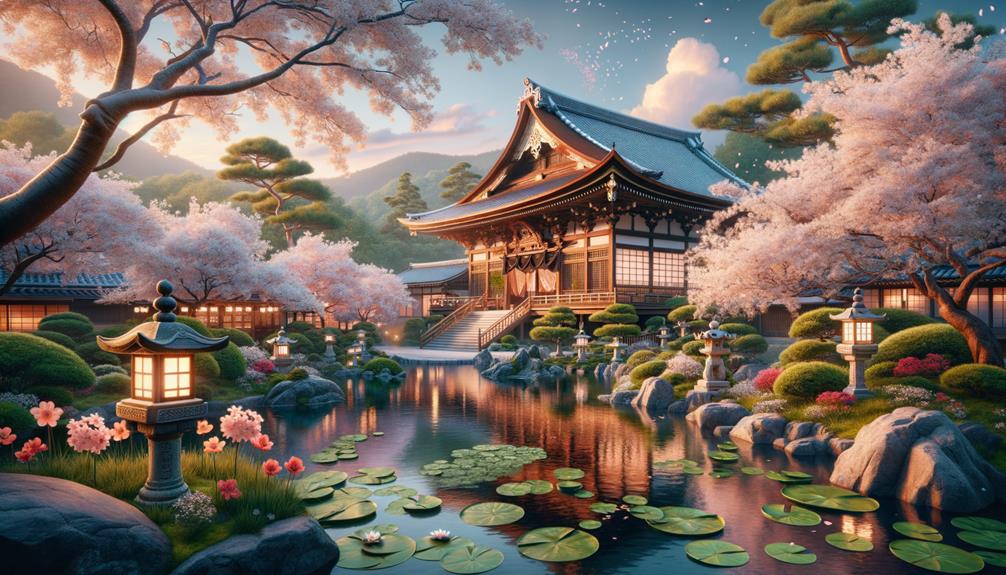You might not know it, but the Kobe Nada Sake District is Japan's largest sake-producing area, contributing to nearly 30% of the country's sake. Walking through its historic streets, you can smell the sweet, fermenting aroma of rice in the air. Each brewery has a unique story, often dating back centuries, blending age-old traditions with modern techniques. What really caught my attention was how the pure waters from Mount Rokko and the prized Yamada Nishiki rice combine to create such a delicate balance of flavors. There's so much more to this quiet yet lively district than meets the eye.
History of Nada Sake
From the Edo period to today, the Nada district has become a powerhouse in sake brewing, thanks to its unique natural resources and innovative techniques. Strolling through Nada, you can almost sense the deep history that permeates the air. This area has been a key player in sake production since the Edo period, boasting centuries of brewing expertise. It's impressive how the ideal brewing conditions here have been so effectively utilized.
The pure underground water from the Rokko mountains boasts a unique mineral composition, making it perfect for brewing high-quality sake. Fast-flowing rivers power rice polishing mills, ensuring the rice is top-notch. This combination of natural resources and human ingenuity has allowed Nada to excel in sake production.
The district's coastal location also plays a significant role, making it easy to import rice and ship sake, further solidifying Nada as a leading sake district. The development of the Yamada Nishiki rice strain, considered the best for brewing, is yet another sign of Nada's historical importance and brewing skill. Reflecting on this, it's clear that Nada's sake production is more than a craft; it's a deeply rooted cultural heritage.
Key Ingredients and Climate

Strolling through the Nada district, it's hard not to appreciate how the pure mountain water from the Rokko range and the Yamada Nishiki rice come together to create top-notch sake. The cool winters here provide an ideal climate for brewing, and the region's natural resources seem perfectly suited for sake production. It's no wonder this place holds such high regard among sake lovers.
High-Quality Brewing Rice
In Kobe's Nada district, the high-quality brewing rice, particularly the famous Yamada Nishiki variety, plays a crucial role in making the region's sake stand out globally. Known for its large grains and low protein content, this rice is carefully grown to meet the high standards needed for top-tier sake. Walking through the fields, you can see the dedication and precision in every stalk of rice.
In Nada, the unique combination of ingredients and climate creates an ideal environment for sake production:
- Yamada Nishiki rice: Often called the 'king of sake rice,' it has perfect attributes for brewing.
- Nada's breweries: Historic establishments with centuries of expertise in sake-making.
- Mountain water: Pure and rich in minerals, sourced from the Rokko mountain range, a key ingredient in brewing.
- Climate: Cool winters and mild summers provide the perfect setting for rice cultivation and sake brewing.
Each sip of sake from Nada tells a story of tradition, precision, and nature's bounty. The clean, crisp mountain water enhances the subtle flavors of the rice, making every bottle a testament to the region's exceptional brewing skills.
Ideal Brewing Environment
Walking through Kobe's Nada district, it's easy to see why this area is renowned for its sake. The region boasts pristine mountain water, an excellent climate, and the finest Yamada Nishiki rice, creating perfect conditions for brewing top-tier sake. The history and cultural heritage of these breweries are palpable as you wander through this sake-making paradise.
Nada sake is rooted in exceptional brewing techniques refined over centuries. Its coastal location not only allows easy access to high-quality Hyogo-grown rice but also makes shipping the finished product a breeze. It's impressive to witness how traditional Japanese methods merge seamlessly with modern technology to maintain the high quality of sake produced here.
The area's mild winters and humid summers provide an ideal environment for fermentation. Coupled with the use of Yamada Nishiki rice, considered the best for sake, this ensures a flavor profile that's hard to beat. The dedication and passion of the brewers, along with these natural advantages, make Nada's sake a true expression of craftsmanship and tradition.
Pure Mountain Water
One of the key elements of Nada's sake craftsmanship is the pure mountain water from the Rokko range. This pristine water, filtered through ancient rock layers, significantly shapes the distinctive flavors and body of each brew. Walking through the Nada district, I was struck by how this water, alongside traditional brewing methods, brings out the best in sake.
Here's what makes Nada's mountain water so special:
- Mineral Content: The water's unique blend of minerals plays a big role in the sake's taste and texture.
- Purity: Naturally filtered, this water provides the clarity needed for high-quality sake.
- Temperature: The cool environment of the Rokko range keeps the water at a steady temperature, perfect for fermentation.
- Availability: Fast-flowing rivers ensure a reliable water source, crucial for large-scale sake production.
Nada's expertise in using this natural resource is truly impressive. Each sip of their sake reflects a long history of refined brewing practices, where pure mountain water is the unsung hero. It's a reminder that sometimes, the simplest elements—like water—are key to creating something exceptional.
Notable Breweries
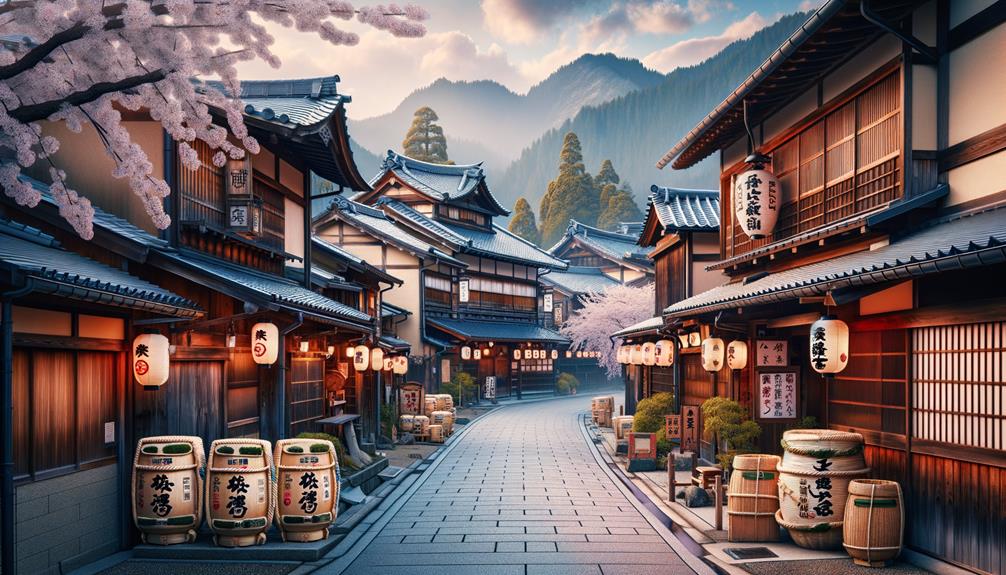
Walking through the Kobe Nada Sake District, I'm amazed by the rich history and skill of well-known breweries like Kobe Shushinkan, Nihonsakari, Hakutsuru, and Sawanotsuru. Each brewery in Nada has its own story and a strong link to sake brewing traditions.
Kobe Shushinkan Brewery, which started in 1751, is famous for its Fukuju brand. The Fukuju sake, which has won gold at the International Sake Challenge, has even been served at the Nobel Prize dinner—a testament to its quality.
At the Nihonsakari brewery near Imazu Station, there's an interesting history exhibit and a shopping area focused on Nada sake. This place provides a real connection to the region's rich brewing roots.
The Hakutsuru Sake Museum offers a deep dive into the history and techniques of Hakutsuru Sake Brewing. Walking through the exhibits, you can feel the dedication and meticulous care that go into every bottle.
Lastly, the Sawanotsuru brewery in Nishi-Go, founded in 1717, showcases the enduring spirit of traditional sake production. Their prominence in the Nada district reflects centuries of expertise.
In this district, every sip tells a story, and each visit deepens my appreciation for this timeless craft.
Brewery Tours and Tastings
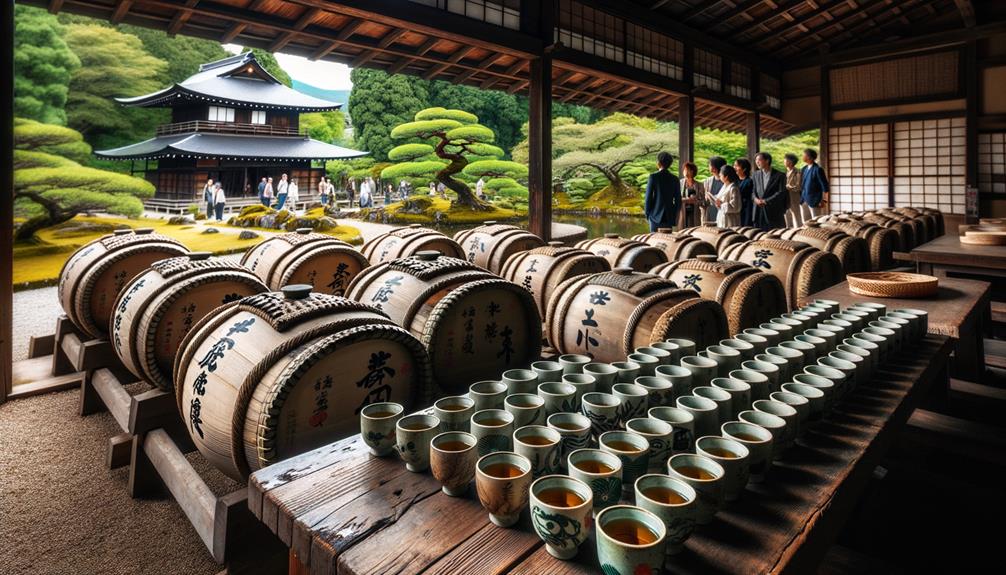
Exploring the Kobe Nada Sake District's historic breweries offers a unique look into the tradition of sake making. Wandering through these sites, I felt deeply connected to centuries of craftsmanship.
At the Kobe Shushinkan Brewery, I joined a free tour and sampled their award-winning Fukuju sake, a brand that has been around since 1751. It was both educational and delicious. If you're hungry, the Sakayabashi restaurant inside the brewery serves traditional Japanese dishes paired with Fukuju sake.
Another highlight in the Nada district is the Hakutsuru Sake Brewery Museum. The museum features interactive exhibits that blend modern technology with age-old brewing techniques, making it a must-visit.
For those who prefer a walking-friendly adventure, these top breweries are conveniently close to each other. Here's a quick list:
- Kobe Shushinkan Brewery – Free tours and tastings.
- Sakayabashi Restaurant – Traditional meals served with sake.
- Hakutsuru Sake Museum – Combines history and modern tech.
- Nihonsakari Brewery – Near Imazu Station, known for premium Daiginjo tastings.
Each visit deepened my appreciation for the rich sake-making heritage of the Nada district.
Cultural Significance
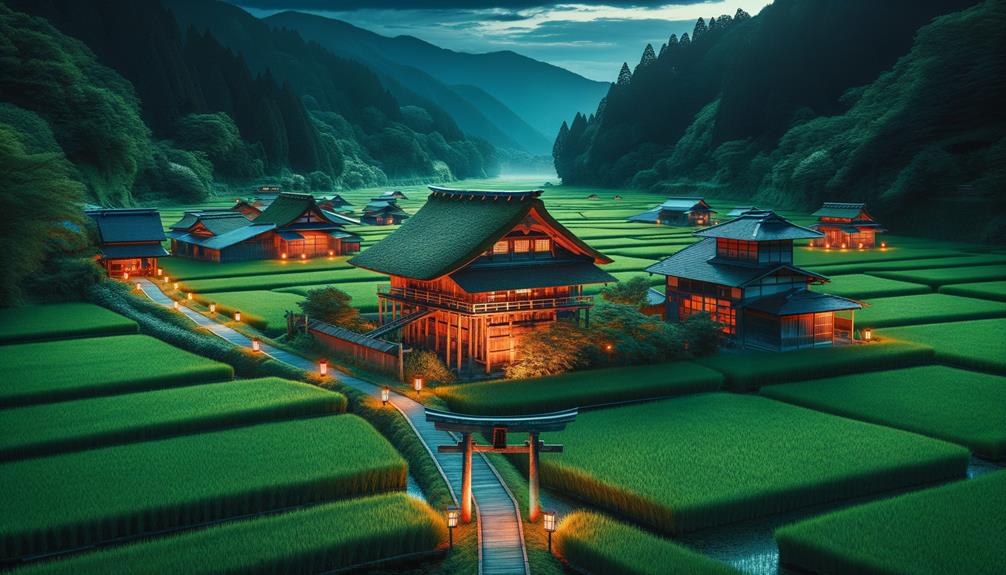
The cultural significance of Kobe's Nada district lies in its deep-rooted Edo-period traditions and exceptional sake production. As I stroll through the area, I can't help but notice how its sake brewing heritage is woven into its very fabric. The centuries-old practices here are meticulously preserved and handed down through generations.
The traditional methods of sake brewing are more than just a craft; they represent a crucial part of Japan's rich cultural heritage. The pure mountain water and the craftsmanship of local brewers highlight the strong bond between the land and its people. It's amazing to think that the techniques perfected during the Edo period are still in use today, creating a direct link to the past.
What really catches my attention are the top breweries based in Nada. These places don't just make award-winning sake; they are a living testament to the district's historical and cultural importance. Nada's coastal location has always been strategic, making it easier to import rice and ship out sake, further embedding the district in Japan's cultural landscape. Every sip of sake here tells a story of tradition, innovation, and cultural pride.
Access and Transportation
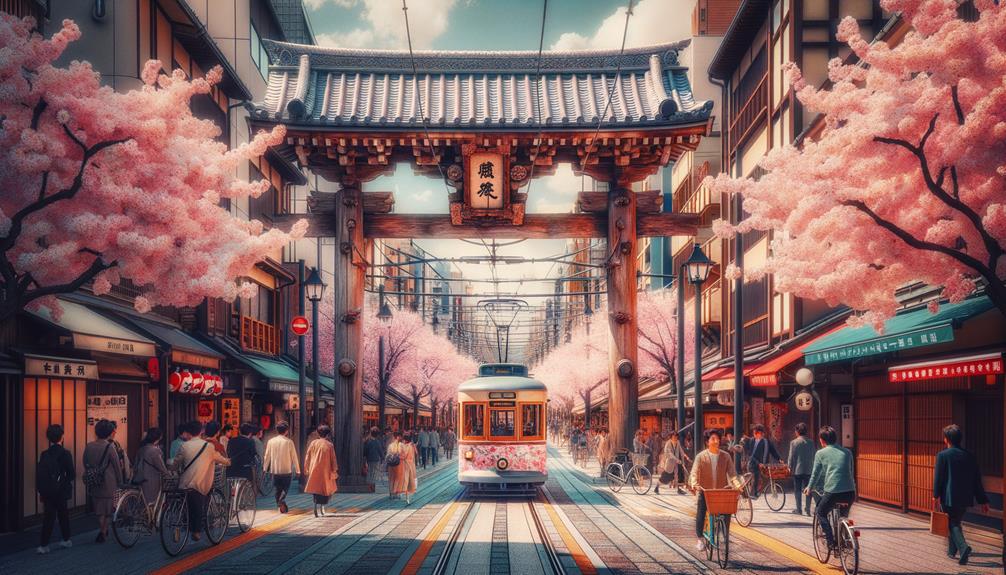
After diving into the rich cultural heritage of the Nada district, I was impressed by how easily accessible its historic breweries are using public transportation. For sake enthusiasts, getting to these breweries is part of the experience, and the Nada district delivers on that front.
Here's a quick rundown of the main transit options:
- Mikage Station: Your entry point to the Kobe Shushinkan Brewery and Hakutsuru Sake Museum, accessible via the Hanshin Line.
- Imazu Station: The nearest stop for the Nihonsakari Brewery, also on the Hanshin Line.
- Hanshin Line: Connects key areas like Kobe Sannomiya, Osaka's Namba, and Umeda, making travel easy.
- Kobe City Bus #16: Offers a scenic ride from Mt. Rokko to the Tokui bus stop, right in the heart of the sake district.
Traveling from busy city centers to these serene breweries, I appreciated how the efficient transportation network connects urban life with traditional sake craftsmanship. Each stop along the way offers a mix of modern convenience and historical charm. For someone like me who loves freedom and exploration, the Nada district's accessibility makes every visit an enjoyable adventure.
Day Trip Itineraries
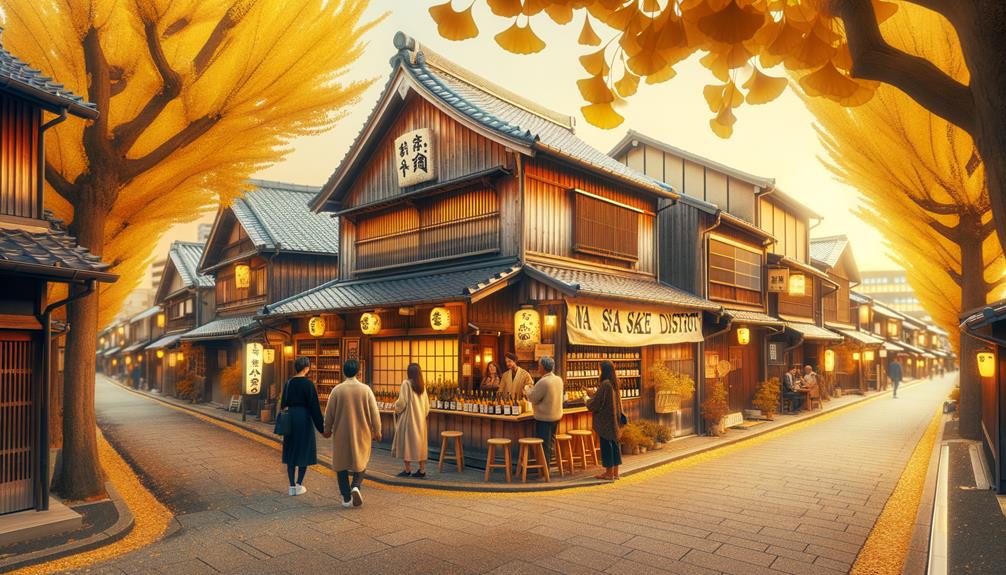
I kicked off my day in the Kobe Nada Sake District with a morning tour at the Kobe Shushinkan Brewery. The craftsmanship behind sake truly amazed me. By the afternoon, I was enjoying different sake varieties at the Hakutsuru Sake Brewery, each sip offering a unique taste of tradition. To wrap up the day, I treated myself to a Kobe beef meal, which perfectly complemented the rich flavors of the sake I had sampled.
Morning Brewery Tour
Exploring Kobe's Nada Sake District in the morning is a delightful way to experience both tradition and innovation. Start with a guided tour at Kobe Shushinkan Brewery or the Hakutsuru Sake Museum. The cool morning air adds to the experience as you learn about the art of sake brewing, a craft honed over centuries.
Wandering through the historic district, you can sense its rich history in the wooden buildings. The guided tour provides a close-up view of the detailed brewing process, from selecting the rice to the precise fermentation techniques. The respect for craftsmanship here is evident.
In the tasting rooms, the experience becomes even more engaging. Sipping on freshly brewed Fukuju sake, you can truly appreciate the artistry in each bottle. The flavors are intricate, a testament to the careful brewing process.
Here's what you can expect on a morning tour:
- Guided exploration of brewing techniques – Learn the intricate steps of sake production.
- Tasting rooms – Sample premium sake varieties.
- Historic district walk – Stroll through picturesque brewery buildings.
- Cultural insights – Understand the deep-rooted sake traditions of Nada.
Each moment of the morning tour feels like a journey through time, blending old-world charm with modern excellence.
Afternoon Sake Tasting
Spending an afternoon tasting sake in Kobe's Nada district is a delightful blend of tradition and modernity. When I stepped into the Kobe Shushinkan Brewery, the rich history of Fukuju sake, dating back to 1751, was immediately palpable. This award-winning brewery offers a taste of Japan's deep heritage. Paired with traditional dishes at Sakayabashi, the delicate flavors of Fukuju sake created an unforgettable dining experience.
My next stop was the Hakutsuru Sake Brewery Museum. There, the sake brewing process came to life, showcasing everything from ancient methods to modern techniques. The engaging exhibits highlighted the craftsmanship and dedication behind each bottle.
Nada district is home to many sake breweries, each with its own unique flavors and stories. A customized tour allowed me to easily hop between tasting rooms, enjoying the variety each brewery had to offer. This afternoon of sake tasting was not just about the drink but also an immersion in culture and history, giving me a deeper appreciation for this timeless craft.
Tips for Visitors

When you're visiting the Kobe Nada Sake District, make sure to wear comfortable shoes, as you'll be exploring a delightful maze of historic breweries and cultural landmarks. The area is a unique blend of tradition and flavor, perfect for a day trip.
Start your adventure at the Hakutsuru Sake Museum, where you can dive into the history and craftsmanship of sake brewing. The interactive exhibits and tasting area are not to be missed. As you wander through the Nada District, you'll find that visiting sake breweries like Kobe Shushinkan is both educational and, quite literally, intoxicating.
To get the most out of your visit, here's a suggested itinerary:
- Sake Museum: Kick off your tour here. The historical artifacts and brewing demonstrations are fascinating.
- Kobe Shushinkan Brewery: Just a short walk away, this brewery combines tradition with modern brewing techniques.
- Tasting Areas: Be sure to sample a variety of sake at each stop.
- Sakayabashi: Wrap up your tour with a meal here, enjoying traditional Japanese dishes paired with award-winning Fukuju sake.
You can easily explore the Nada District at your own pace, thanks to convenient access via Mikage and Imazu Stations.
Frequently Asked Questions
Is Kobe Known for Sake?
Absolutely, Kobe's sake has a global reputation. I've tried it myself, and its rich flavor and full body are truly memorable. The unique brewing conditions and top-quality rice make Kobe a dream destination for sake enthusiasts. It's genuinely outstanding.
Where Is the Best Sake Producing Region in Japan?
The Nada district stands out as Japan's top sake-producing region. Its special mix of high-quality rice, pure mountain water, and ideal climate makes visiting its historic breweries an unforgettable experience.
Who Owns Sawtelle Sake?
Sawtelle Sake, a hidden gem in Los Angeles, was created by Yoshihiro Sako, a master brewer with over 30 years of experience. His dedication to traditional techniques brings a slice of Japanese culture to American shores.

